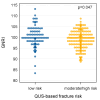The Association Between Nutritional Risk and Bone Stiffness in Elderly Men and Women in a Population-Based Study in Northeast Germany
- PMID: 39770909
- PMCID: PMC11676822
- DOI: 10.3390/nu16244288
The Association Between Nutritional Risk and Bone Stiffness in Elderly Men and Women in a Population-Based Study in Northeast Germany
Abstract
Background: The Geriatric Nutritional Risk Index (GNRI) has shown promising potential for identifying individuals at risk for osteoporosis in various patient cohorts. However, data from the general population confirming or refuting the usefulness of the GNRI as a risk factor for osteoporosis are sparse. We therefore aimed to clarify whether the GNRI is associated with the ultrasound-based bone stiffness index and the osteoporotic fracture risk in a sample of elderly men and women from the general population.
Methods: Data from 1417 participants in the Study of Health in Pomerania START-2 or TREND-0 aged 65 years or older with quantitative ultrasound measurements at the heel and GNRI values were examined. In cross-sectional linear and logistic regression models, associations between the GNRI and heel stiffness index or ultrasound-based osteoporotic fracture risk were examined. All analyses were repeated after stratification of the study population according to BMI (underweight/normal weight, overweight and obese).
Results: In underweight/normal weight individuals, higher, i.e., better, GNRI values had a positive effect on the stiffness index (β-coefficient per standard deviation increase in GNRI = 2.69, standard error = 1.00, p = 0.007). With increasing GNRI values, underweight/normal weight elderly men and women also had higher chances of a low osteoporotic fracture risk (odds ratio 1.42, 95% confidence interval 1.04-1.94, p = 0.026). Corresponding associations in overweight or obese individuals were absent.
Conclusions: In elderly men and women with underweight/normal weight, the GNRI is positively associated with the bone stiffness index and the related osteoporotic fracture risk. In this group, the GNRI may prove useful in identifying individuals with an elevated fracture risk.
Keywords: BMI; bone stiffness; elderly men and women; nutritional risk; osteoporosis; quantitative ultrasound; underweight.
Conflict of interest statement
The authors declare no conflicts of interest.
Figures


Similar articles
-
Low geriatric nutritional risk index is associated with osteoporosis and fracture risk in patients with chronic liver disease: a cross-sectional study.BMC Gastroenterol. 2024 Oct 24;24(1):376. doi: 10.1186/s12876-024-03465-8. BMC Gastroenterol. 2024. PMID: 39448932 Free PMC article.
-
Geriatric nutritional risk index (GNRI) as a predictor of fragility fracture risk in older adults living with HIV: a 10-year retrospective longitudinal cohort study from China.Arch Osteoporos. 2025 May 9;20(1):62. doi: 10.1007/s11657-025-01543-2. Arch Osteoporos. 2025. PMID: 40341968
-
Association between the Geriatric Nutritional Risk Index, bone mineral density and osteoporosis in type 2 diabetes patients.J Diabetes Investig. 2020 Jul;11(4):956-963. doi: 10.1111/jdi.13196. Epub 2020 Jan 20. J Diabetes Investig. 2020. PMID: 31828962 Free PMC article.
-
Physical frailty and oral health as risk factors for low bone density in community-dwelling residents.Sci Rep. 2024 Aug 5;14(1):18131. doi: 10.1038/s41598-024-68958-8. Sci Rep. 2024. PMID: 39103423 Free PMC article.
-
Relationship between geriatric nutritional risk index and osteoporosis in type 2 diabetes in Northern China.BMC Endocr Disord. 2022 Dec 9;22(1):308. doi: 10.1186/s12902-022-01215-z. BMC Endocr Disord. 2022. PMID: 36494810 Free PMC article.
References
-
- Camacho P.M., Petak S.M., Binkley N., Diab D.L., Eldeiry L.S., Farooki A., Harris S.T., Hurley D.L., Kelly J., Lewiecki E.M., et al. American Association of Clinical Endocrinologists/American College of Endocrinology Clinical Practice Guidelines for the Diagnosis and Treatment of Postmenopausal Osteoporosis-2020 Update. Endocr. Pract. 2020;26((Suppl. S1)):1–46. doi: 10.4158/GL-2020-0524SUPPL. - DOI - PubMed
-
- Kanis J.A., Cooper C., Rizzoli R., Scientific Advisory Board of the European Society for Clinical and Economic Aspects of Osteoporosis (ESCEO) and the Committees of Scientific Advisors and National Societies of the International Osteoporosis Foundation (IOF) European guidance for the diagnosis and management of osteoporosis in postmenopausal women. Osteoporos. Int. 2019;30:3–44. doi: 10.1007/s00198-018-4704-5. - DOI - PMC - PubMed
MeSH terms
Grants and funding
LinkOut - more resources
Full Text Sources
Medical

